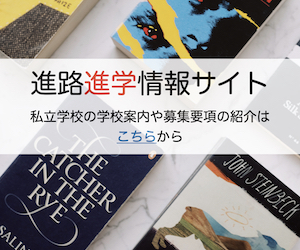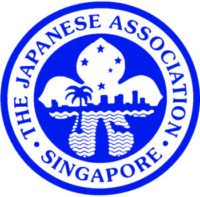Annual School events & activities
Graduation Ceremony
Students finishing 6 years of primary education and 3 years of secondary education participate in the Graduation Ceremony, both held in March. They receive their Certificate of Graduation from the principal in the presence of the Japanese Ambassador, the president of the Japanese Association, a member of the School Management Committee, guests and parents.
Entrance Ceremony
The school year begins in April, as it does in Japan. New students and their parents attend an Entrance Ceremony, where they are addressed by the principal and teachers about what they may expect of the school. Students are always excited at the prospect of embarking on the adventure of school life.
School Anniversary
The School was founded on September 3rd, 1966. Each year, the anniversary is celebrated by a special assembly of staff and students, during which the principal or a guest speaker talks about the history of the Japanese School and expresses a wish for the continuation of the existing good relations between Singapore and Japan.
School Exchange Programmes
Primary School pupils of both Clementi and Changi campuses enjoy the mingling and interaction with local primary school children several times a year. They spend half a day playing traditional games, creating crafts and making friends with each other. Upper level students of the Primary School conduct an overnight stay at each other’s house and spend two full days at their partner’s school.
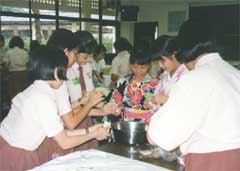
Secondary School students voluntarily take part in the Local Immersion Programme at the schools connected to the Ministry of Education Language Centre. They spend a week at local schools, staying with local families. Their experiences will surely enhance their understanding of Singapore and her people. The Japanese School reciprocates by receiving Singaporean students in September, where they are immersed in the Japanese culture.
Teacher Exchange Programme
Teachers from both the Changi campus and the local primary schools have recently begun meeting and learning from each other. This teacher exchange enables the Japanese teachers to sit in, observe and teach in the local schools and for the local school teachers to do the same at the Japanese School. This is usually followed by some discussion later.
Sports Day
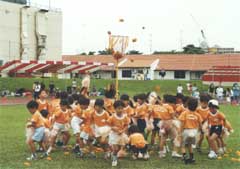
One of the main events of the year is the Sports Day, which is held on the grounds of each Japanese School respectively and the public stadium.
International Swimming Gala
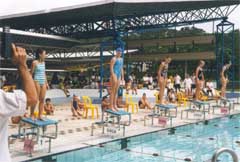
The Primary school organises a yearly swimming competition among most of the international schools and the local schools in Singapore. Participants from all over the world share the happy memory of this gathering.
Morning Assembly
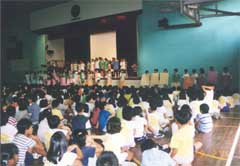
Morning assembly is held twice or three times a month once a term English Immersion Assembly is carried out in English for the students to reinforce their communicative English ability. The morning assembly is organized by the teachers. Students are addressed by the principal and teachers and, on certain occasions, are presented with prize certificates. The assembly plays an important role in encouraging students to embody the high ideals and fellowship of the Japanese School.
Students’ Assembly
A Students’ Assembly is held once a month. It is organized by the students themselves. During the students’ assembly, announcements are made and occasionally, students will give a short performance.
Cultural Festival (Secondary School)
The event called “BUNKA-SAI” is translated as Cultural Festival. This is basically to present their artistic and academic skills. The students invite their friends and parents and spend two full days introducing their various works in exhibitions. There are also performances such as the singing contest among the students of different classes.
Japanese Cemetery Visit

The Japanese Cemetery is cleaned by the students of the Japanese School. While there, they pray to the ancestors, and remember the hardships faced by them. They offer joss sticks, flowers to console the spirits and give thanks for the community’s comforts here in Singapore.
School Excursion
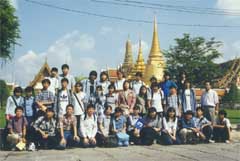
The highlight of the year for primary six students is their two day School Graduation Excursion to Malaysia. As for the secondary two students, their highlight is a four day School Graduation Excursion to Thailand. Not only do they gain valuable experience by visiting traditional places and seeing the customs of the people, they also gain an insight into the enjoyment and responsibilities of communal living.
Both primary and secondary schools form Student Councils. Representatives from each class organise an Executive Committee to run the Council, while the General Assembly has the final say.

Under the Executive Committee, there are various types of specialised-committees that are attended by all the students. They aim to improve their school life and make it meaningful.
Student Council and their activities
Special committees supported by the teachers
*Assembly Committee
*Broadcasting Committee
*Physical Education Committee
*Library Committee
*Health/Hygiene Committee
*Planting/Breeding livestock Committee
*General Executive Committee
*Social Life Committee
*Environment Committee
*Music Committee
Secondary Special committees
*General Executive Committee
*International Relations Committee
*Physical Education Committee
*Social Life Committee
*Study & Library Committee
*Publishing “Yashi (Palm tree)” Committee
*Broadcasting Committee
*Health & Hygiene Committee
*Election Committee
Extra-Curricular Activities
Upper grades of the primary and all the secondary school students are encouraged to take part in extra-curricular activities, either in sports or cultural clubs. There are also Boy Scout & Girl Guide Groups available besides the ECAs listed below. These activities provide facilities for the mental, physical and moral development of the students.
Primary
* Sports Club
Basketball
Volleyball
Softball
Soccer
Game
Computer
Japanese Drum
Science
Illustration & Craft
Kendama
* Cultural Club
Cooking
Handicrafts
Comics
Dancing
Game
Secondary
* Sports Club
BaseBall
Soccer
Athletics
Volley Ball
Tennis
Basket Ball
Badminton
Table Tennis
* Cultural Club
Art Painting
Brass Band
Computer
Dancing
Rock Music Band
Daily Schedule
The schools operate in a single full-day session. As students come to school by school buses in the morning, they wait for their homeroom teachers to take the roll call. They are given 10 minutes breaks between classes which are 45 minutes long (50 minutes for secondary school).
They take lunch after the 4th period in their classroom with their friends and teachers. They bring their lunches which are prepared by their parents everyday except for Saturday. After school, some students in the secondary stay back for ECA (Extra-Curricular Activities), but most of the students take the school bus home.
Time Schedule A Week
At the primary school, there is a morning assembly every Monday. Tuesday through Friday morning meetings are held in each classroom. The lesson begins at 8.40 for 45minutes. There are 10 minutes intervals between lessons. In the morning session, there is a 20 minute rest from 10.20 to make pupils relax. Lunch starts at 12.20 till 13.10. Monday, Wednesday and Friday, school is over at 14.25, All pupils ride on the school buses to go home. However on Tuesday and Thursday, pupils leave school late at 15.30 to attend an additional lesson.
At the Secondary School, the lesson starts at 8.45 after a short meeting every day. Each lesson lasts for 50 minutes and there are 10 minutes intervals between lessons. The pupils leave school at 15:50 on Monday to Friday.
Examination
Schooling from Primary 1 up to Secondary 3 for 9 years is compulsory in the Japanese education system: The students can attain a Certificate of Graduation as long as they perform modestly to the requirements.
The Primary School gives no standardized tests for screening or streaming. They may take achievement tests to identify their level of understanding in order for teachers to plan better and for parents and children to know their level of achievement.
The Secondary School students are expected to take two exams in each of the three terms, namely mid term and term-end exams. Their results from the term exams will affect their selection of high schools and their performance must be reported to the high schools to which they apply.
In the Japanese system, the highest academic pressure on students is felt by high schools preparing for the entrance screening.

